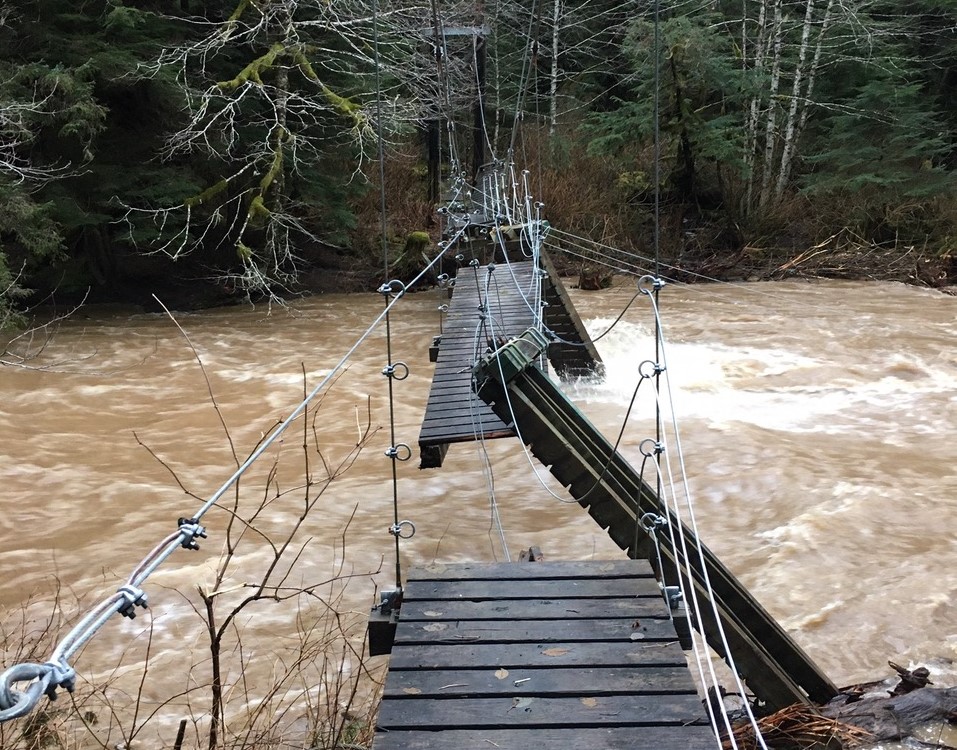
Last December, a record-breaking storm caused landslides and flooding around Southeast Alaska. In the roughly 100-person town of Tenakee Springs, the storm destroyed a bridge that provides vital access for a handful of residents. Now, the community’s turning to crowdfunding to help rebuild it.
On Dec. 2, Tenakee residents awoke to find their beaches littered with logs as big as two and a half feet in diameter. Gordon Chew was part of the clean-up crew at the time.
“We’ve been out all morning here with the tide coming in because the entire beach in front of all our houses is literally just littered with debris that’s come down out of the rivers,” he said when he spoke to KCAW on the morning after the storm. “Never seen anything like this before in the almost 20 years we’ve been here.”
A gauge on the mountain behind town recorded more than five inches of rainfall in 24 hours, according to the National Weather Service in Juneau. The storm uprooted trees and sent them hurtling downstream, clogging culverts and causing flooding. They also knocked out the 32-year-old Indian River Bridge, which stood around 20 feet above the river.
“It was well built and it just never even crossed our mind that a whole pile of trees would come floating down and catch it with their big tall branches,” Tenakee Spings resident Steve Lewis said.
The bridge served as the only land access to town for him and his partner Rachel Myron. Since December, they’ve relied on their skiff to get supplies, pick up their mail, and visit with friends. But rough weather, tides, and darkness can make accessing town by water tricky for the handful east end residents. Myron and Lewis live four and a half miles outside of town.
“In terms of our lifestyle, we’re tied to that bridge. It’s important to us,” Myron said. “One of the reasons we enjoy and chose to live here is kind of that reassurance of access to town and in particular the infrastructure of the ferry and all of that.”
But it’s more than just practical. Myron said the suspension footbridge was symbolic of the town’s commitment to pedestrian access. The town has strict limitations on cars, and Myron and Lewis’ house isn’t even accessible by ATV.
And, she said, it was a joy to walk across.
“I always hung out in the middle of the bridge where the bouncing effect was the biggest. And from there you can look up and down river and watch the bears and the salmon and just celebrate where we are,” she said.
Mayor Dan Kennedy said the town has reached out to state and federal officials about possible disaster relief funds to help rebuild the city-owned bridge. The town’s partially finished hydroelectric plant was also badly damaged in the storm along with two other bridges.
“We don’t know if we’re gonna get any disaster relief funds or state funds or FEMA funding. Probably even if we do, it’ll be a year or two down the line, which isn’t very acceptable for the residents out there,” Kennedy said.
The city doesn’t have the money to repair the bridge on its own, so when a local resident started a $15,000 GoFundMe account, the council thought, ‘why not?’ With some volunteer labor and local expertise, the fund should cover the cost to rebuild the bridge and restore access for east end residents.
“Very similar to when we have an accident or the situation with the entangled whale or whatever, everybody who knows how to help comes together and finds a way to help each other in this town and that’s one of the beauties of living here,” Lewis said.
So far, the fund is about a fifth of the way toward its goal. Kennedy said if they do receive state or federal funding down the line, they’ll reimburse the costs. But in the meantime, he said, they couldn’t afford to wait.
Editor’s note: A previous version of this story incorrectly stated that the Indian River bridge was 22-years-old. Erin McKinstry is a Report for America corps member.






























